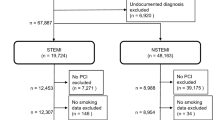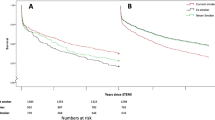Abstract
Data derived from several studies suggest a better survival in smokers with acute myocardial infarction, a phenomenon referred to as the ‘smoker’s paradox’. We aimed to investigate the association of smoking with cardiac magnetic resonance (CMR) imaging determined infarct severity and major adverse cardiac events (MACE) defined as the occurrence of death, reinfarction, and congestive heart failure at 12 months in patients with non-ST-elevation myocardial infarction (NSTEMI) reperfused by early percutaneous coronary intervention (PCI). In this multicenter, registry study 311 NSTEMI patients underwent CMR imaging 3 (interquartile range [IQR] 2–4) days after PCI. Myocardial salvage index (MSI), infarct size (IS), and microvascular obstruction (MVO) as well as MACE rate were compared according to admission smoking status. Approximately one-third of patients were current smokers (n = 122, 39%). Smokers were significantly younger and less likely to have hypertension as compared to non-smokers (all p < 0.05). The extent of MSI (63.2, IQR 28.9–85.4 vs. 65.6, IQR 42.2–82.9, p = 0.30), and IS (7.2, IQR 2.3–15.7%LV vs. 7.0, IQR 2.2–12.4%LV, p = 0.27) did not differ significantly between smokers and non-smokers. Despite similar prevalence of MVO, MVO (%LV) was higher in smokers compared to non-smokers (2.0, IQR 0.9–4.7%LV vs. 1.2, IQR 0.7–2.2%LV, p = 0.03). MACE rates at 12 months were comparable in smokers and non-smokers (5.7% vs. 7.4%, p = 0.65). In NSTEMI patients, smoking is neither associated with increased myocardial salvage nor less severe myocardial damage. Clinical outcome at 12 months was similar in smokers and non-smokers.
Trial registration NCT03516578.


Similar content being viewed by others
References
Camici PG, Crea F (2007) Coronary microvascular dysfunction. N Engl J Med 356(8):830–840
Barua RS, Ambrose JA (2013) Mechanisms of coronary thrombosis in cigarette smoke exposure. Arterioscler Thromb Vasc Biol 33(7):1460–1467
Molstad P (1991) First myocardial infarction in smokers. Eur Heart J 12(7):753–759
Barbash GI, White HD, Modan M, Diaz R, Hampton JR, Heikkila J et al (1993) Significance of smoking in patients receiving thrombolytic therapy for acute myocardial infarction. Experience gleaned from the International Tissue Plasminogen Activator/Streptokinase Mortality Trial. Circulation 87(1):53–58
Grines CL, Topol EJ, O’Neill WW, George BS, Kereiakes D, Phillips HR et al (1995) Effect of cigarette smoking on outcome after thrombolytic therapy for myocardial infarction. Circulation 91(2):298–303
Barbash GI, Reiner J, White HD, Wilcox RG, Armstrong PW, Sadowski Z et al (1995) Evaluation of paradoxic beneficial effects of smoking in patients receiving thrombolytic therapy for acute myocardial infarction: mechanism of the “smoker’s paradox” from the GUSTO-I trial, with angiographic insights. Global Utilization of Streptokinase and Tissue-Plasminogen Activator for Occluded Coronary Arteries. J Am Coll Cardiol 26(5):1222–1229
Ruiz-Bailen M, de Hoyos EA, Reina-Toral A, Torres-Ruiz JM, Alvarez-Bueno M, Gomez Jimenez FJ et al (2004) Paradoxical effect of smoking in the Spanish population with acute myocardial infarction or unstable angina: results of the ARIAM Register. Chest 125(3):831–840
Albertal M, Cura F, Escudero AG, Thierer J, Trivi M, Padilla LT et al (2008) Mechanism involved in the paradoxical effects of active smoking following primary angioplasty: a subanalysis of the protection of distal embolization in high-risk patients with acute myocardial infarction trial. J Cardiovasc Med 9(8):810–812
Verouden NJ, Haeck JD, Kuijt WJ, Meuwissen M, Koch KT, Henriques JP et al (2010) Clinical and angiographic predictors of ST-segment recovery after primary percutaneous coronary intervention. Am J Cardiol 105(12):1692–1697
Kim RJ, Fieno DS, Parrish TB, Harris K, Chen EL, Simonetti O et al (1999) Relationship of MRI delayed contrast enhancement to irreversible injury, infarct age, and contractile function. Circulation 100(19):1992–2002
Wu KC, Zerhouni EA, Judd RM, Lugo-Olivieri CH, Barouch LA, Schulman SP et al (1998) Prognostic significance of microvascular obstruction by magnetic resonance imaging in patients with acute myocardial infarction. Circulation 97(8):765–772
Wagner A, Mahrholdt H, Holly TA, Elliott MD, Regenfus M, Parker M et al (2003) Contrast-enhanced MRI and routine single photon emission computed tomography (SPECT) perfusion imaging for detection of subendocardial myocardial infarcts: an imaging study. Lancet 361(9355):374–379
de Waha S, Desch S, Eitel I, Fuernau G, Zachrau J, Leuschner A et al (2010) Impact of early vs. late microvascular obstruction assessed by magnetic resonance imaging on long-term outcome after ST-elevation myocardial infarction: a comparison with traditional prognostic markers. Eur Heart J 31(21):2660–2668
Bellenger NG, Davies LC, Francis JM, Coats AJ, Pennell DJ (2000) Reduction in sample size for studies of remodeling in heart failure by the use of cardiovascular magnetic resonance. J Cardiovasc Magn Reson 2(4):271–278
Eitel I, Kubusch K, Strohm O, Desch S, Mikami Y, de Waha S et al (2011) Prognostic value and determinants of a hypointense infarct core in T2-weighted cardiac magnetic resonance in acute reperfused ST-elevation-myocardial infarction. Circ Cardiovasc Imaging 4(4):354–362
Eitel I, de Waha S, Wohrle J, Fuernau G, Lurz P, Pauschinger M et al (2014) Comprehensive prognosis assessment by CMR imaging after ST-segment elevation myocardial infarction. J Am Coll Cardiol 64(12):1217–1226
Desch S, Engelhardt H, Meissner J, Eitel I, Sareban M, Fuernau G et al (2012) Reliability of myocardial salvage assessment by cardiac magnetic resonance imaging in acute reperfused myocardial infarction. Int J Cardiovasc Imaging 28(2):263–272
Eitel I, Desch S, Fuernau G, Hildebrand L, Gutberlet M, Schuler G et al (2010) Prognostic significance and determinants of myocardial salvage assessed by cardiovascular magnetic resonance in acute reperfused myocardial infarction. J Am Coll Cardiol 55(22):2470–2479
Reinstadler SJ, Eitel C, Fuernau G, de Waha S, Desch S, Mende M et al (2017) Association of smoking with myocardial injury and clinical outcome in patients undergoing mechanical reperfusion for ST-elevation myocardial infarction. Eur Heart J Cardiovasc Imaging 18(1):39–45
Gennaro G, Brener SJ, Redfors B, Kirtane AJ, Genereux P, Maehara A et al (2016) Effect of smoking on infarct size and major adverse cardiac events in patients with large anterior ST-elevation myocardial infarction (from the INFUSE-AMI trial). Am J Cardiol 118(8):1097–1104
de Waha S, Eitel I, Desch S, Scheller B, Bohm M, Lauer B et al (2013) Thrombus Aspiration in ThrOmbus containing culpRiT lesions in Non-ST-Elevation Myocardial Infarction (TATORT-NSTEMI): study protocol for a randomized controlled trial. Trials 14:110
Stiermaier T, Eitel I, de Waha S, Poss J, Fuernau G, Thiele H et al (2017) Myocardial salvage after primary percutaneous coronary intervention in patients with ST-elevation myocardial infarction presenting early versus late after symptom onset. Int J Cardiovasc Imaging 33(10):1571–1579
Klug G, Mayr A, Schenk S, Esterhammer R, Schocke M, Nocker M et al (2012) Prognostic value at 5 years of microvascular obstruction after acute myocardial infarction assessed by cardiovascular magnetic resonance. J Cardiovasc Magn Reson 14:46
Mayr A, Pedarnig K, Klug G, Schocke M, Pachinger O, Jaschke W et al (2012) Regional functional recovery after acute myocardial infarction: a cardiac magnetic resonance long-term study. Int J Cardiovasc Imaging 28(6):1445–1453
Mayr A, Klug G, Feistritzer HJ, Reinstadler SJ, Reindl M, Esterhammer R et al (2017) Myocardial edema in acute myocarditis: relationship of T2 relaxometry and late enhancement burden by using dual-contrast turbo spin-echo MRI. Int J Cardiovasc Imaging 33(11):1789–1794
Feistritzer HJ, Klug G, Reinstadler SJ, Grober MT, Mair J, Kirchmair R et al (2015) Fetuin-A is related to infarct size, left ventricular function and remodelling after acute STEMI. Open Heart 2(1):e000244
Thiele H, Kappl MJ, Conradi S, Niebauer J, Hambrecht R, Schuler G (2006) Reproducibility of chronic and acute infarct size measurement by delayed enhancement-magnetic resonance imaging. J Am Coll Cardiol 47(8):1641–1645
Reinstadler SJ, Stiermaier T, Reindl M, Feistritzer HJ, Fuernau G, Eitel C et al (2019) Intramyocardial haemorrhage and prognosis after ST-elevation myocardial infarction. Eur Heart J Cardiovasc Imaging 20(2):138–146
Symons R, Masci PG, Francone M, Claus P, Barison A, Carbone I et al (2016) Impact of active smoking on myocardial infarction severity in reperfused ST-segment elevation myocardial infarction patients: the smoker’s paradox revisited. Eur Heart J 37(36):2756–2764
Ibanez B, James S, Agewall S, Antunes MJ, Bucciarelli-Ducci C, Bueno H et al (2018) 2017 ESC Guidelines for the management of acute myocardial infarction in patients presenting with ST-segment elevation: the Task Force for the management of acute myocardial infarction in patients presenting with ST-segment elevation of the European Society of Cardiology (ESC). Eur Heart J 39(2):119–177
Gottlieb S, Boyko V, Zahger D, Balkin J, Hod H, Pelled B et al (1996) Smoking and prognosis after acute myocardial infarction in the thrombolytic era (Israeli Thrombolytic National Survey). J Am Coll Cardiol 28(6):1506–1513
Andrikopoulos GK, Richter DJ, Dilaveris PE, Pipilis A, Zaharoulis A, Gialafos JE et al (2001) In-hospital mortality of habitual cigarette smokers after acute myocardial infarction; the “smoker’s paradox” in a countrywide study. Eur Heart J 22(9):776–784
Weisz G, Cox DA, Garcia E, Tcheng JE, Griffin JJ, Guagliumi G et al (2005) Impact of smoking status on outcomes of primary coronary intervention for acute myocardial infarction–the smoker’s paradox revisited. Am Heart J 150(2):358–364
Allahwala UK, Murphy JC, Nelson GI, Bhindi R (2013) Absence of a ‘smoker’s paradox’ in field triaged ST-elevation myocardial infarction patients undergoing percutaneous coronary intervention. Cardiovasc Revasc Med 14(4):213–217
Park HW, Yoon CH, Kang SH, Choi DJ, Kim HS, Cho MC et al (2013) Early- and late-term clinical outcome and their predictors in patients with ST-segment elevation myocardial infarction and non-ST-segment elevation myocardial infarction. Int J Cardiol 169(4):254–261
Wakabayashi K, Romaguera R, Laynez-Carnicero A, Maluenda G, Ben-Dor I, Sardi G et al (2011) Impact of smoking on acute phase outcomes of myocardial infarction. Coron Artery Dis 22(4):217–222
Author information
Authors and Affiliations
Corresponding author
Ethics declarations
Conflict of interest
The authors declare that they have no conflict of interest.
Additional information
Publisher’s Note
Springer Nature remains neutral with regard to jurisdictional claims in published maps and institutional affiliations.
Rights and permissions
About this article
Cite this article
Feistritzer, HJ., Eitel, I., Jobs, A. et al. Impact of smoking on cardiac magnetic resonance infarct characteristics and clinical outcome in patients with non-ST-elevation myocardial infarction. Int J Cardiovasc Imaging 35, 1079–1087 (2019). https://doi.org/10.1007/s10554-019-01556-2
Received:
Accepted:
Published:
Issue Date:
DOI: https://doi.org/10.1007/s10554-019-01556-2




